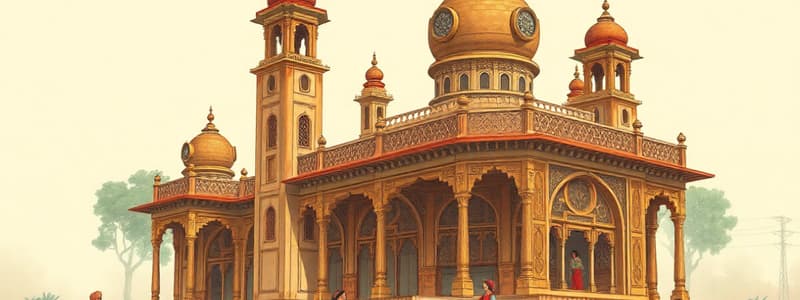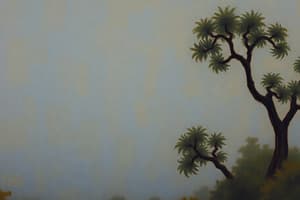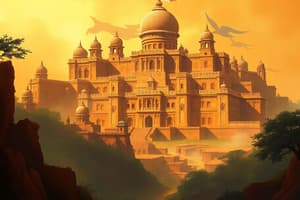Podcast
Questions and Answers
Which of the following concepts relates to the social structure of Ancient India?
Which of the following concepts relates to the social structure of Ancient India?
- Moksha
- Samsara
- Karma
- Purushartha (correct)
During which century did significant social and religious reform movements take place in India?
During which century did significant social and religious reform movements take place in India?
- 18th and 19th Century
- 16th and 17th Century
- 19th and 20th Century (correct)
- 14th and 15th Century
Which of the following is NOT a major festival traditionally celebrated in Madhya Pradesh?
Which of the following is NOT a major festival traditionally celebrated in Madhya Pradesh?
- Diwali
- Makar Sankranti
- Holi
- Baisakhi (correct)
Which geographical feature is a prominent aspect of Madhya Pradesh?
Which geographical feature is a prominent aspect of Madhya Pradesh?
What was a major factor contributing to India's environmental challenges?
What was a major factor contributing to India's environmental challenges?
Which body is primarily responsible for the judicial system in India?
Which body is primarily responsible for the judicial system in India?
Which resource is crucial for irrigation projects in Madhya Pradesh?
Which resource is crucial for irrigation projects in Madhya Pradesh?
Which aspect does the term 'Gantantra' refer to in Indian history?
Which aspect does the term 'Gantantra' refer to in Indian history?
Flashcards
What is the Varnashrama system?
What is the Varnashrama system?
The philosophical and social system of ancient India, based on the idea of 'dharma' (duty) and 'karma' (action), with emphasis on righteous living, social order, and spiritual liberation.
What are the 'Purushartha'?
What are the 'Purushartha'?
The four purposes of human life in Hinduism, described in the texts like the Bhagavad Gita: Dharma (duty), Artha (wealth), Kama (desire), and Moksha (liberation).
What are the Vedas?
What are the Vedas?
The collection of ancient Indian scriptures, categorized into Rig Veda, Sama Veda, Yajur Veda, and Atharva Veda, containing hymns, rituals, knowledge, and philosophical insights.
What are the Shaddarshana?
What are the Shaddarshana?
Signup and view all the flashcards
What is Bharatvarsha?
What is Bharatvarsha?
Signup and view all the flashcards
What is the Medieval Period of India?
What is the Medieval Period of India?
Signup and view all the flashcards
What were the Social and Religious Reform Movements?
What were the Social and Religious Reform Movements?
Signup and view all the flashcards
What was the Indian Independence Struggle?
What was the Indian Independence Struggle?
Signup and view all the flashcards
Study Notes
History of India
- Concepts and Ideas: Ancient Indian knowledge tradition, Bharatvarsha, Vedas, Upanishads, Aranyakas, Brahman Granth, Shaddarshan, Smritiyan, Rit Sabha-Samiti, Gantantra (Republic), Varnashrama, Purushartha, Rin Sanskara, Panch Mahayagya, Principle of Karma, Bodhisatva, Teerthankar.
- Salient features and systems of ancient and medieval India: Social and economic systems, art forms, literature, and festivals.
- India's Cultural Heritage: Art forms, literature, festivals, and events
- Social and Religious Reform Movements (19th & 20th centuries)
- Independence Struggle and Indian National Movement
- Integration & Reorganization of India after Independence: Post-independence events and developments in India.
History, Culture, and Literature of Madhya Pradesh
- Major Events and Dynasties
- Contribution to the freedom movement
- Major arts and sculptures
- Major tribes and dialects
- Major festivals, folk music, folk arts, and folk literature
- Important literary creators and their works
- Important religious, cultural, and archaeological sites
Geography of India
- Mountains, hills, plateaus, rivers, and lakes
- Climate phenomena (El Niño, La Niña, Southern Oscillation, Western Disturbances) and consequences of climate change
- Natural resources: Forests, minerals, water resources
- Major crops, food security, and the Green Revolution
- Conventional and non-conventional energy sources
- Natural hazards (disasters) and major cyclones in India
- Population growth, distribution, and density, rural-urban migration
Geography of Madhya Pradesh
- Forests, forest produce, rivers, hills, and plateaus
- Climate (seasons, temperature, and rainfall)
- Natural resources (soils, major minerals)
- Major crops, water resources, and irrigation projects
- Conventional and non-conventional energy sources
- Major industries of Madhya Pradesh
- Population growth, distribution, density, and urbanization
Constitutional System of India and Madhya Pradesh
- Constituent Assembly
- Federal Executive (President and Parliament)
- Supreme Court and Judicial System
Studying That Suits You
Use AI to generate personalized quizzes and flashcards to suit your learning preferences.




